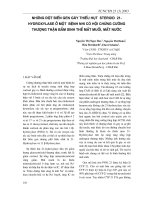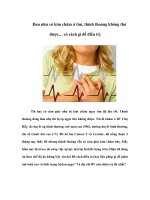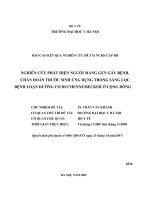Sàng lọc bệnh nhi có tiếng thổi ở tim
Bạn đang xem bản rút gọn của tài liệu. Xem và tải ngay bản đầy đủ của tài liệu tại đây (657.06 KB, 24 trang )
Heart Murmur in Infancy
Cao Viet Tung MD
National Hospital of Pediatrics
Cardiovascular Examination
l
l
History
Physical Examination
Inspection
n Palpation
n Auscultation
n
l
Noninvasive studies
HISTORY
l
l
l
l
l
l
When was the murmur first detected?
What were the circumstances?
Signs/Symptoms/Review of Systems
Perinatal history
Medical history
Family history
Physical Exam: INSPECTION
l
l
l
l
l
l
l
Vital signs (BP, HR, RR, & SaO2)
General state of health/nutrition
Degree of comfort/activity level
Skin: pallor, cyanosis, clubbing, edema?
Respiratory effort/pattern
Shape of chest and precordial activity
Dysmorphic features
Physical Exam: PALPATION
l
Pulses - radial, brachial, & femoral
rate
n rhythm
n volume
n character
n
l
l
Precordium/suprasternal notch
Liver/spleen/thyroid
Auscultatory Areas
A
P
T
M
Auscultatory Findings
l
l
l
Rate
Rhythm
Heart Sounds
1st, 2nd, 3rd, and 4th
n clicks
n rubs
n
l
Murmurs (systolic and diastolic)
HEART SOUNDS
l
1st Heart Sound (S1)
n
l
AV valve closure
2nd Heart Sound (S2)
n
Semilunar valve closure
HEART SOUNDS
l
3rd Heart Sound (S3)
n
l
Rapid ventricular filling
4th Heart Sound (S4)
n
Ventricular filling with atrial contraction
Characteristics of a
Heart Murmur
l
l
l
l
l
Intensity
Timing
Frequency
Location and Radiation
Variation with Position/Maneuvers
INTENSITY
l
l
l
l
l
l
Grade I = barely audible
Grade II = easily heard
Grade III = moderately loud
Grade IV = loud with thrill
Grade V = with steth. edge on chest
Grade VI = with steth. off chest
Factors Effecting Intensity
l
l
l
l
l
Fever
Anemia
Exercise
CHF
Position/Maneuvers
TIMING
Relationship to S1 and S2
l
Systolic Ejection Murmur (SEM)
S1
S2
TIMING
Relationship to S1 and S2
l
Holosystolic/Pansystolic Murmur
S1
S2
TIMING
Relationship to S1 and S2
l
Decrescendo Diastolic Murmur
S1
S2
TIMING
Relationship to S1 and S2
l
Atrial Flow Murmur (Diastolic)
S1
S2
S1
TIMING
Relationship to S1 and S2
l
Atrial Contraction Murmur (Diastolic)
S1
S2
S1
TIMING
Relationship to S1 and S2
l
Continuous Murmur
S1
S2
S1
Noninvasive Studies
l
Electrocardiogram
l
Chest X-Ray
l
Echocardiogram
Common Normal Heart Murmurs
Vibratory Systolic Murmur (Still’s)
Pulmonary Flow Murmur
Peripheral Pulmonary Stenosis
Cervical Venous Hum
Carotid Bruit/Supraclavicular Systolic Murmur
Most Common Pathologic Murmurs
Aortic Stenosis
Pulmonary Stenosis
Coarctation of the Aorta
Atrial Septal Defect (ASD)
Ventricular Septal Defect (VSD)
Most Common Pathologic Murmurs
Patent Ductus Arteriosus (PDA)
Tetralogy of Fallot (TOF)
Mitral Insufficiency(regurgitation)
Aortic Insufficiency (regurgitation)
Congenitalsuspected
Heart Defect
a.
History, P/E
b. Chest film
c. ECG
Patient acyanotic
PBF
LVH or
Combined
VSD
PDA
AVSD
RVH
ASD
PAPVC
Patient cyanotic
PBF
PBF normal
LVH
AS
MR
CoA
d.
LVH or
Combined
RVH
PS
MS
Truncus A.
Single V.
TGA/VSD
2 – D Echo
PBF
RVH
LVH
RVH
Combined
Tricuspid A.
Hypo.RV
TOF
Ebstein’s
TAPVC
Hypo LV
TGA
TGA/PS
Single V-PS
Definitive diagnosis
Heart murmur in Newborn infant
History, P/E
Grade intensity of murmur
Grade 1~2
No CHF or cyanosis
Innocent murmur
Grade 3~6
CHF or cyanosis
Serious anomaly
Systolic ejection
At birth
Continuous
Pt.2~3wks
of age
Pul. Flow murmur
Vibratory murmur
Transient m. of PDA
TGA,TOF
TAPVC,
Hypo LV
Hypo RV
AS
PS
CoA
VSD
PDA









